
Test Drive Unlimited
Written by: Rik
Date posted: December 15, 2013
- Genre: Racing
- Developed by: Eden Games
- Published by: Atari
- Year released: 2007
- Our score: 8
When we last dropped in on the Test Drive series, it wasn’t doing so well. But whatever else was wrong with Test Drive III: The Passion, it was at least faithful to the spirit of the series: a fast car, some open road, and a liberal sprinkling of traffic and police. That was the last the world saw of Test Drive for a while, although after a long hiatus the brand was revived and stamped on a series of largely unheralded lap-based racers. In the meantime, The Need for Speed had established itself as a spiritual successor, although before long it, too, abandoned the point-to-point approach in favour of circuits dressed up as roads (wearing ‘road trousers’, if you will).
Test Drive Unlimited represents an attempt to return to the series’ original ethos. With the passage of time arming developers with the requisite technological horsepower, TDU does open-world racing on a much larger scale than had ever previously been possible. In place of the claustrophobic urban environments of the likes of Midtown Madness or Midnight Club II it offers the lush greenery of the Hawaiian island of Oahu – and that’s the whole island, rather than a scaled-down approximation, with over 1,000 miles of open road to explore.
Rather than a linear series of races and championships, TDU is structured more like an RPG, to the extent that some consideration was given to categorising it as such on the site [the answer’s still no – FFG board]. The game begins with you choosing an avatar from a limited selection of male and female alternatives who are all hanging around in an airport lounge. As usual, the men all look like wannabe musicians while the women (sigh) are dressed in unlikely and impractical outfits. You can tinker with your character’s appearance later, if such things bother you, although given that you can’t see him/her while you’re driving it hardly seems worth the effort.
Anyway, for reasons that are neither explained nor worth giving much further consideration, your character then boards a flight bound for Oahu, with just enough cash for a house with a large garage and a brand new car. Dotted around the island are a variety of races and challenges that give you the opportunity to earn money and other rewards that can be used to build up a collection of cars, houses and, er, clothes (we’ll get to that).
At this point it’s probably worth mentioning that, at the time of release, the online element of TDU was a significant and prominent part of the overall package. In another nod to the RPG genre, the game’s packaging gushes excitedly about an ‘elite global community of racers’ and referring to the unnecessarily-trademarked acronym ‘M.O.O.R.’ (which apparently stands for Massively Open Online Racing). In an uncharacteristic move for this site, we have actually tried the multiplayer, although it amounted to little more than a couple of hours’ arsing around in a couple of the entry-level cars, eschewing contact with all other players, and as such hardly qualifies as a decent test.
Your correspondent’s own prejudices against online gaming aside, there seems little point dwelling on it now, given that the servers have been turned off and no-one will ever get to experience it again anyway. We cover games in the state they’re in at the time of writing, usually by which time all the gloss and fab-whizzo features from the time of release have faded, and in this case that means multiplayer. However, it matters not, because this was absolutely not the part of the game that attracted me to it in the first place, and the game works perfectly in offline mode as a single-player, go anywhere racer. Indeed, when cut-down versions of TDU were released on PS2 and PSP, neither of which were able to boast significant online features, the marketing focus was realigned with an emphasis on the solo experience.
Anyway, after some initial hand-holding, the player is presented with a map of the island, with various races and other missions highlighted. The competitive racing generally falls into three categories: race, time and speed. Races are against other cars, usually around a circuit, time challenges require you to beat the clock, while speed challenges either involve maintaining an average speed through a handful of checkpoints or hitting a specified top speed within a time limit. At any time you may or may not have to contend with traffic, or deal with the demands of a driving meter that penalises you every time you leave the road or collide with something (if it goes down to zero, it’s race over; otherwise, a time penalty is applied).
The reward for success in all three is money – there are usually gold, silver and bronze trophies available, so if you don’t finish first (or get the best time/speed) you can still be rewarded for near misses. In terms of achievements that earn you XP, gold cups are what’s needed, but it’s good that the game gives out something for all those failed attempts. You can also come back for another go (for the same cash reward) even if you’ve already secured the gold cup, although money should never really get that tight and there’s rarely a shortage of new races to conquer.
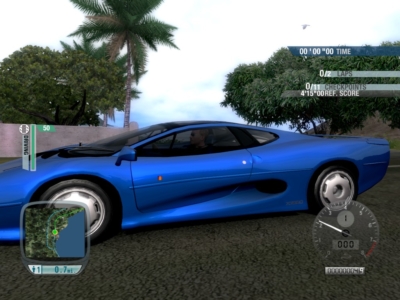
‘Classic’ cars are also available – including the Jaguar XJ220. If anyone tries to tell you the 90s were cool, show them this picture.
The race, time and speed challenges are supplemented by various missions. Courier and vehicle transport missions also pay cash, and they’re pretty lucrative, although you can’t go back and do them again once completed. Courier missions are point-to-point challenges against the clock, while vehicle transport involves delivering a car that isn’t your own, with no time limit, but with money knocked off your final total for erratic driving (the driving meter makes a reappearance here). On top of this you have hitchhiker and, ahem, ‘top model’ missions, which involve you either giving a lift to an unemployed male surfer/musician or a scantily dressed woman with shopping bags, delivering them to their chosen destination against the clock. The reward for success this time is clothing vouchers, with which you can visit one of the island’s licensed outlets and play dress-up with your avatar. (For more on which, see Can you give me a ride a little ways?).
Although the races available to you are marked on the map, you still have to drive there unless you’ve done so previously, while missions are uncovered as you explore the island. Either way, you have to get used to driving around, which is fitting, because that’s really what TDU is all about – the pleasure of the open road. Even in the earliest available set of cars, it isn’t a chore, and just driving around for the sake of it is probably how you’ll spend the first few hours at least.
You have traffic to take into account, of course, and it has to be said that the inhabitants of Oahu, as represented here, have a propensity for sudden and unnecessary lane changes that occasionally necessitate sharp evasive manoeuvres. Cars coming in the opposite direction also seem to appear out of nowhere, and if it weren’t for the fact they always have their headlights on (even though it’s always sunny and never gets overcast or dark) you’d have even more trouble overtaking. The police also have a presence, although sensibly this hasn’t been made a focus of the game. They generally remain ignorant of speeding or otherwise irresponsible driving as long as you don’t collide with any other cars. Occasional paint-trading with civilian traffic will also go unpunished as long as it isn’t repeated almost immediately, but if you do start smashing into things a lot and evade arrest, the cops can be pretty tenacious, chasing after you, setting up roadblocks, and fining you heavily should they manage to get you to stop. It’s a decent compromise that acts as a deterrent against twatty driving without requiring you to be too careful about your speed or the presence of cop cars in general.
The game is at its best when you’re dealing with a long stretch of road, weaving in and out of traffic, avoiding collisions but taking risks. When TDU plays to these strengths, usually in the timed challenges and missions, it makes for some truly exhilarating racing. When a section of the road is cordoned off and the traffic excluded to make a circuit, then things aren’t quite so good, with some of the longer lap-based races proving a bit of a chore to complete. TDU also doesn’t seem to cope too well with the twisty-turny elements of driving, and none of your vehicles seem to be equipped to handle corners and jumps as you might expect. At times it calls to mind the original Need for Speed, which was great when racing down a long highway, but came a cropper when more subtlety was required.
NFS didn’t exactly deal with collisions and crashes in a realistic way, either, with the illusion created by the (at the time) stunning graphics being all-too-easily shattered by the presence of ‘invisible wall’ syndrome and lack of crash impact. You get the same feeling here; one minute you’re enjoying the decent visuals and good sense of speed, the next, you’re spinning off the road and crashing into a house with nothing more than a sudden loss of momentum and a sound akin to the noise you hear when returning a shopping trolley to show for it. Perhaps going from the likes of FlatOut 2 to this accentuated things slightly, but the fact that the cars don’t roll or show any damage is slightly jarring (even NFS managed those ridiculous crash sequences).
To be clear: you can leave the road, but a collision with virtually any roadside object will bring you to a halt. As such, bar the odd cheeky short-cut across a grass verge or a brief stint on the wrong side of the carriageway, there’s little potential for off-roading or finding alternative routes, in a way that will actually help you. And speaking of leaving the road, it can become a regular occurrence if you happen to purchase and drive one of the slippier vehicles on offer. Although there are ratings for handling, among other things, which you can review prior to purchasing a car, it seems to have little correlation with how you’ll actually get on with it once you’re on the road. Fortunately, especially given the name of the game, you can ‘test drive’ any vehicle for a couple of minutes, which is much more useful. (A quick spin is also enough to reveal some unexpectedly wimpy engine sounds, too – I’m no expert, and I’m sure they’ve all been accurately captured using some high-falutin’ technology, but some just don’t sound right at all to me).
At the risk of going all Jeremy Clarkson here, a significant proportion of the available cars are twitchy, unpredictable beasts (*turns to camera and goes ‘whhhooooaaaaarrr’, as a prelude to footage of a wheelspin*) that are frankly a chore to drive. This is particularly the case with ‘A’ class vehicles, at the top end of TDU’s spectrum, which seem to have far too much power than is good for them, to the extent that even the most reluctant of arcade-racer chimps (and I speak as one) will need to switch to a manual gearbox just to be able to change up early and avoid losing control. (Having said all that, though, these are the cars that can get up to 250mph+, which can be a thrill, even if it does feel more like you’re attempting a land speed record than anything else).
In terms of making progress, it’s fair to say that there’s plenty of content here when you’ve had enough of driving around. There are 120 races and 100 missions, fed to you in dribs and drabs in a way that doesn’t make it feel too much like a grind. At times the XP system can cause dismay, as the system seems to be designed to make you feel crap, rewarding you in chunks once you’ve completed a set target (e.g. gold cups in 20 races) rather than just dishing it out as you play. So you could be playing for hours, just messing around and doing the occasional race, and still be confronted with a fairly pathetic completion percentage. In many ways it’s a testament to how much fun it is not to play TDU ‘properly’ that you can spend so much time with it and not really have scratched the surface. Fortunately there are some fairly arbitrary acquisition-based tasks that you can do for some easy points (although I did hesitate before and then shudder after completing the ‘own 10 items of Ben Sherman clothing’ achievement).
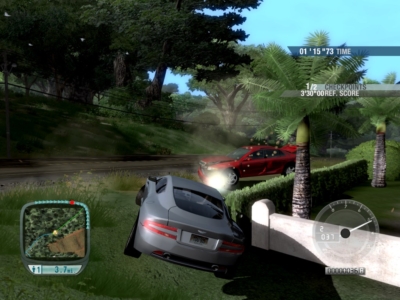
Okay, so the unlicensed civilian car has some minor damage. But the rest of this isn’t right at all.
Acquisition and accumulation of items in TDU is a curious thing indeed. Taking a utilitarian view, you really don’t need to own a lot of cars – many can simply be rented for vehicle/brand-specific challenges – and owning one of the best in each class will pretty much do you for the rest. If you don’t need many cars, you certainly don’t need many houses with garages to keep them in either. But still, even as someone largely uninterested in the real-life world of high-performance motoring, I still found myself staying up late to complete an extra couple of challenges so I could add another to my collection. And then having that car meant I could complete another couple of challenges. And then – whoops – I seemed to suddenly have quite a lot of money going spare, so why not buy another house? And with the new house, there’s so much more garage space, so another car wouldn’t be out of the question…and so on. (Adding designer t-shirts and jeans to my avatar’s wardrobe didn’t quite have the same appeal, though).
Still, TDU isn’t really about a utilitarian…anything. It’s about swanking about in fast cars on a permanently-sunny island (thus failing my windscreen-wiper fetish test, incidentally). The non-linear structure keeps you going, and for the most part you feel as if you can do as you please. Once you’ve built up an empire of luxury mansions with garages full of supercars, and completed all of the single-player challenges, there will come a point when it will be left alone. But, because it offers such a distinctive experience, you’ll still probably come back for more. It’s not without flaws – we haven’t even mentioned the terrible menu interface, with useful options dotted across no less than three separate pause screens – but on the whole TDU achieves most of its rather ambitious goals, retrieving the TD name from the gutter in the process. For anyone who loved The Duel, The Need for Speed or Car and Driver, this is a must.

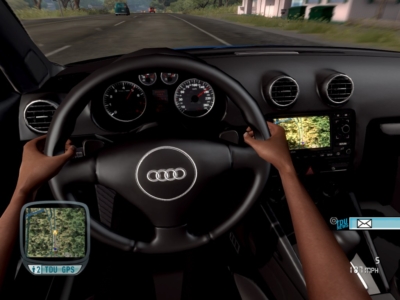
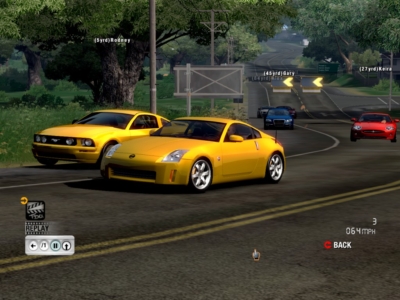
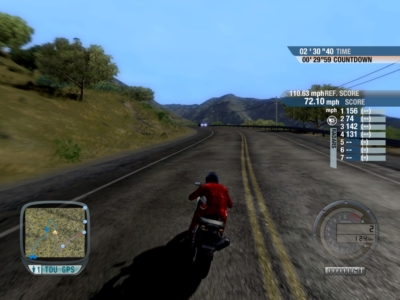


 Posts
Posts
Nice write-up. To my mind, you´ve absolutely covered all the game´s attractions (and its idiosyncracies). I´ve been enjoying this game in single-player mode for 5 years (!) now. What has contributed to this veeeery long-term enjoyment, though, is the fact that through mods from a very active modding community a whole lot of stuff, most importantly a sheer endless list of other vehicles than those originally included in the game can be added (e.g. Bugatti Veyron, Pagani Huayra, Lamborghini Aventador, McLaren 12C and P1, Ferrari 458, Aston Martin DBS, Bugatti 57 Atlantic, Ferrari 250 Testa Rossa, Citroen SM, Mitsubishi Evo X, etc.). Modding tools allow you to make the car perform the way you want them to (ideally to render performance as realistic as possible). If you prefer, you can even jump back in time and modify the game, so that it´s 1975 on Oahu (including historical vehicles and police cars as traffic). So even after having explored every nook and cranny of TDU´s open world, this adds further experiences, keeps a very old game up to date vehicle-wise and makes Test Drive literally unlimited.
August 14, 2014 @ 3:22 pm
Hi Karsten, thanks for reading.
I never tried any mods, I have to admit. I did give the sequel a bit of a go, but was put off by the story elements and some fairly terrible performance on my ageing machine.
August 17, 2014 @ 1:50 pm